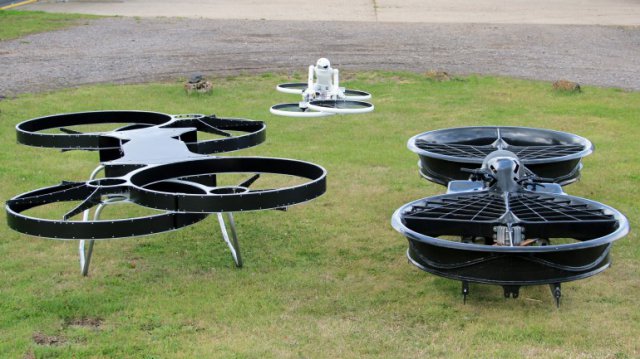 An interesting Kickstarter project aims to jump-start sales of a drone version of a fully-functional hover bike. The quadcopter drone acts as a proof of concept for the full-sized manned vehicle, with proceeds from the crowdfunding effort intended to fuel the continued development of the final vehicle. With more than a week remaining before the Kickstarter campaign concludes, its funding goal has been exceeded and development is moving forward at pace. Though the manned Hoverbike is what tends to garner the most attention, the one third scale drones are actually the focus of the Kickstarter effort.
An interesting Kickstarter project aims to jump-start sales of a drone version of a fully-functional hover bike. The quadcopter drone acts as a proof of concept for the full-sized manned vehicle, with proceeds from the crowdfunding effort intended to fuel the continued development of the final vehicle. With more than a week remaining before the Kickstarter campaign concludes, its funding goal has been exceeded and development is moving forward at pace. Though the manned Hoverbike is what tends to garner the most attention, the one third scale drones are actually the focus of the Kickstarter effort.
At this stage, there are three versions of the Hoverbike. The original two rotor manned vehicle, the quadcopter drone, and the still-in-development second prototype Hoverbike.
Thanks to the crowdfunding campaign, we’ve seen quite a lot of the drone, but the full-sized vehicle, in its MK2 state, has remained something of a mystery. Though we’re still a few months out from seeing the finished prototype, the full-sized Hoverbike is already an imposing sight. The quadrotor frame is similar to the drones offered on Kickstarter, but decidedly more angular, constructed from a combination of carbon sheet and aircraft-grade aluminum.
The design of the manned vehicle is cleverly thought out and features a number of interesting design points, such as adjustable weighting in the central section to ensure correct balancing regardless of pilot physique, a self-cutting rotor channel, and offset rotor placement.
In its current, rotor-less state, the inside of the circular, protective blade housing is filled with UV-stabilized polycarbonate (as pictured below). Once the rotors are fitted, they’ll cut through the material, creating a channel that reduces the clearance between the propeller top and duct wall.
The offset design of the four rotors allows the protective frame around one of the blades to be used as a mounting for the other, meaning that the revised vehicle can keep its narrow profile, making it practical for negotiating difficult terrain.
Though the act of designing and creating a fully functional hover bike may seem technologically Herculean, there’s no practical barrier to making it happen, at least not with the quadrotor design Chris Malloy and his team are working on with the Hoverbike. While public skepticism may be a significant barrier, the real challenge is bringing together existing technology, while making the vehicle safe, practical and economically viable.
The move from a dual to quad rotor setup is all about stability. The original Hoverbike design was certainly eye-catching, but it suffered from significant practical problems – namely, that if it were to reach a certain angle in a turn, it would become difficult for the pilot to right the vehicle. This is no longer an issue with the quadcopter design, with the varying thrust of the four rotors affording the vehicle significant stability.
If you find yourself talking to someone about a project such as this, one paramount area of concern that quickly arises is safety, and understandably so. Despite its name, the Hoverbike is not a hovercraft. It will travel up to altitudes in the thousands of feet, as well as achieve significant forward momentum.
One key piece of the puzzle here, and something that should assuage many safety concerns, is that the manned Hoverbike will be equipped with autopilot capabilities, just like the drone version. This means that though the vehicle can be piloted, a significant margin of human error can be removed from the equation.
The autopilot function also provides the option to remotely control the craft, making it well suited to supply drops, search and rescue operations over difficult terrain, and a whole host of other applications. From mountain rescue scenarios to Red Bull Air Race-esque sports applications, the list of potential uses for the vehicle seems practically endless.
With the Kickstarter project having already exceeded its funding goal, and with murmurs of outside funding, the project is moving full steam ahead. Once the crowdfunding effort concludes on August 31, the team will continue to sell the quadcoptor drones, and plans to test the manned-vehicle within a few months.
Photos: Chris Wood/Gizmag
Source: Gizmag



